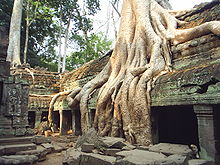Tetrameles
| Tetrameles | |
|---|---|
 |
|
| The famous tree growing in the Ta Prohm temple ruins in Cambodia is Tetrameles nudiflora | |
| Scientific classification | |
| Kingdom: | Plantae |
| Clade: | Angiosperms |
| Clade: | Eudicots |
| Clade: | Rosids |
| Order: | Cucurbitales |
| Family: | Tetramelaceae |
| Genus: |
Tetrameles R.Br. |
| Species: | T. nudiflora |
| Binomial name | |
|
Tetrameles nudiflora R.Br. |
|
Tetrameles is a genus of flowering plants in the family Tetramelaceae with one species, Tetrameles nudiflora. It grows as a large deciduous tree and is found across southern Asia from India through southeast Asia, Malesia, and into northern Australia.
Tetrameles nudiflora grows as a large dioecious tree to 45 m tall with a spread of over 10 m. The trunk is buttressed, and the bark is grey and often shiny. The tree often contains large hollows in the trunk or branches. It is deciduous, bare of leaves between October and December in Australia and typically January-April in Vietnam.
Many specimens have grown to immense proportions of height and width. In Vietnam, a number of fine specimens are shown to visitors in Cat Tien National Park – one within walking distance of the park headquarters.
Robert Brown described Tetrameles nudiflora in 1844, from material collected in Java. Its species name is derived from the Ancient Greek tetra "four" and melos "part", and refers to the flower having four sepals. The species name is from the Latin nudiflora "bare flowers". It is the only species in its genus Tetrameles. It and Octomeles sumatrana are the only two species in the family Tetramelaceae. They were previously classified in the Datiscaceae but found genetically to not form a natural clade with the other members of that family.
Tetrameles nudiflora is found from India and Sri Lanka, Bangladesh, Bhutan, Burma, China, Laos, Cambodia, Thailand, and Vietnam, Malaysia, Indonesia, and into the Cape York Peninsula in north Queensland (Australia).
...
Wikipedia

